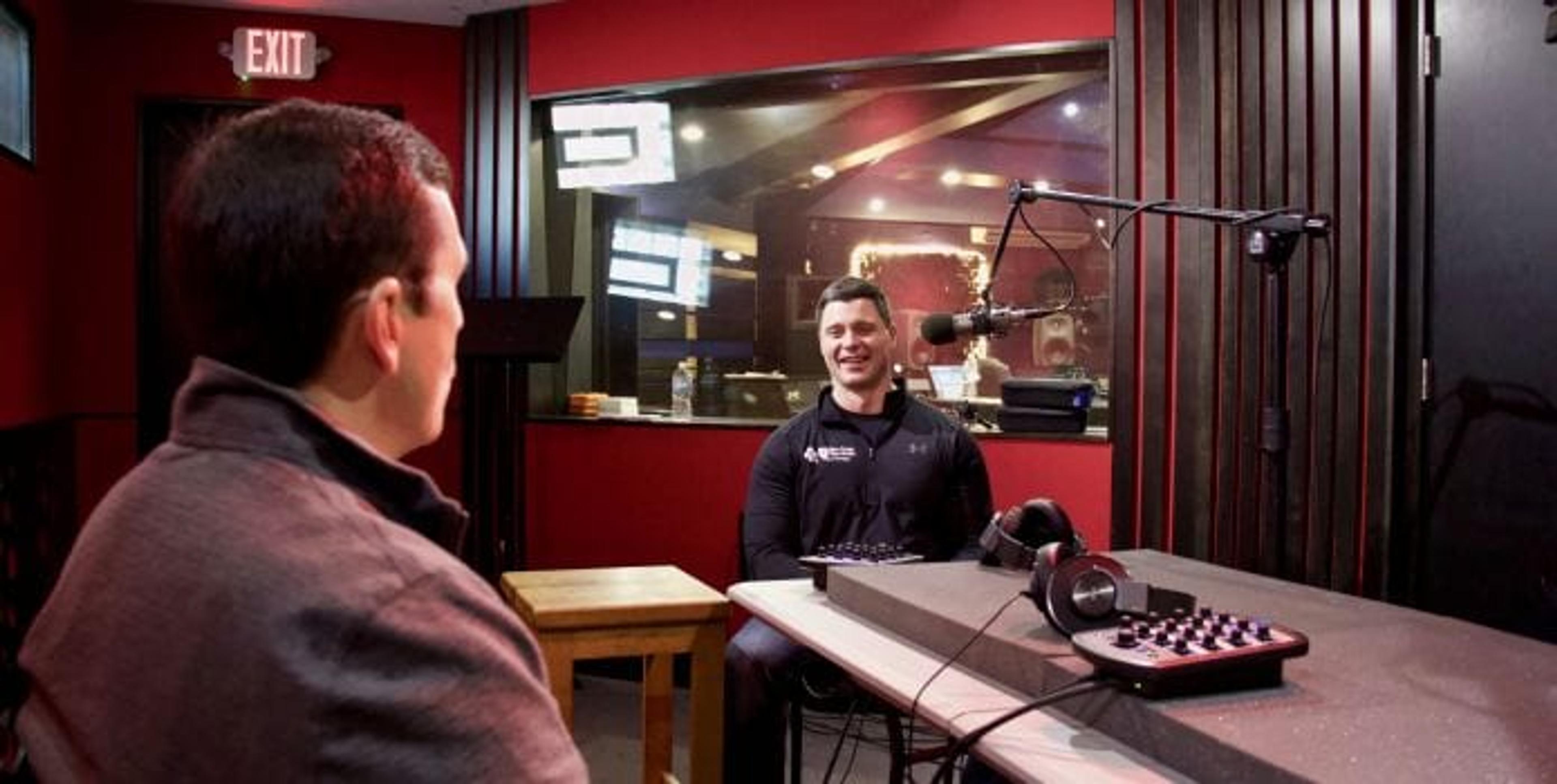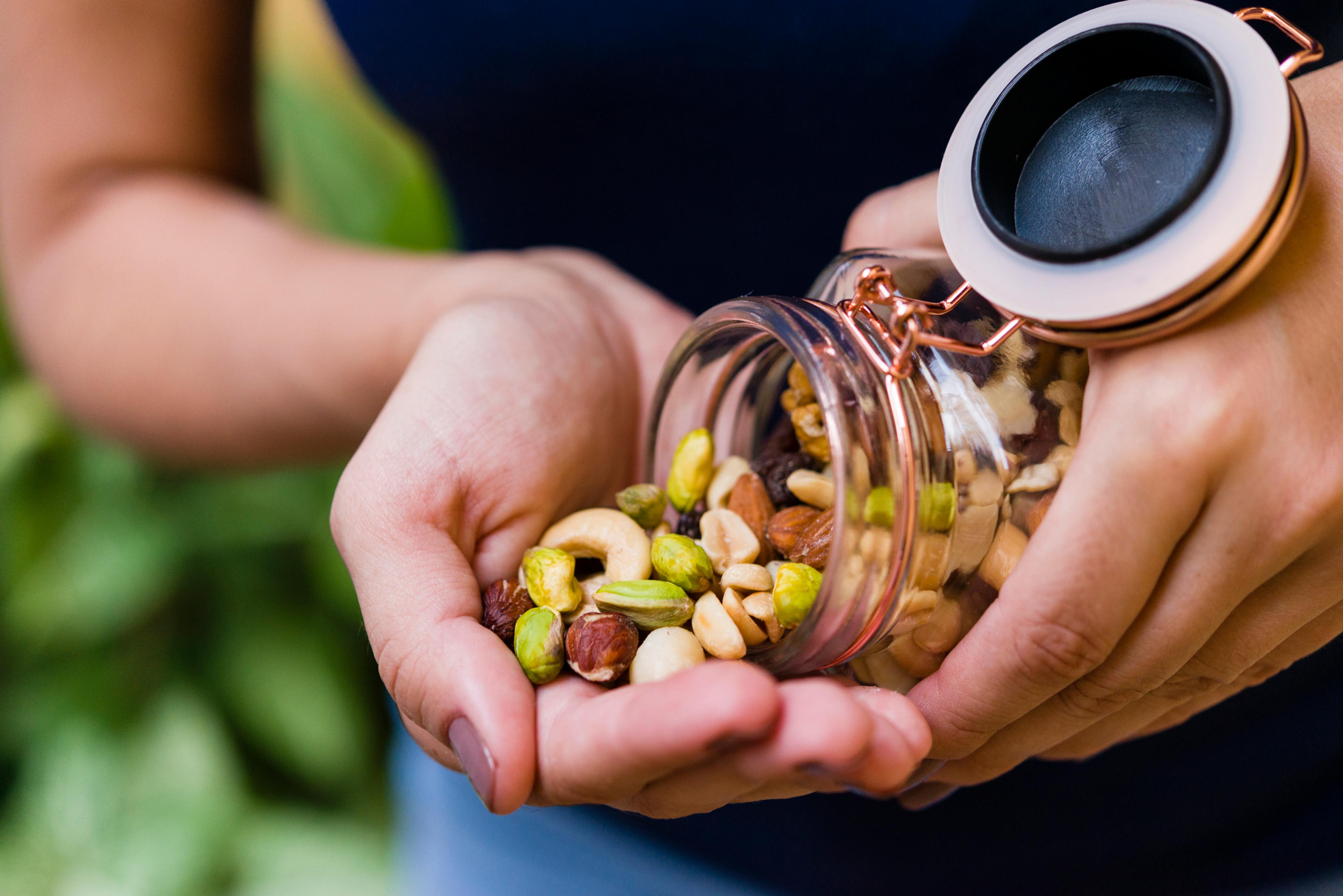Aerobic vs Anaerobic – What’s the Difference?
| 1 min read

00:00
00:00
About the Show
On this episode, Chuck Gaidica is joined by manager and wellness coordinator Vince McKinnon to discuss the differences between aerobic and anaerobic exercise, as well as the importance of knowing your max heart rate.
“People need to understand that aerobic [is] more slow burn, slow-twitch fibers, anaerobic [is] more fast-twitch. It’s going to burn more glycogen. They serve two different purposes. For the most part, we would do aerobic two to three times a week and maybe throw in some anaerobic in there a couple times a week.” – Vince McKinnon
In this episode of A Healthier Michigan Podcast, we explore:
- What is aerobic exercise
- What is anaerobic exercise
- What to do when your body adapts to a workout
- The difference between high and low intensity training
- Why it’s important to burn glycogen
- How to calculate your max heart rate
Transcript
Chuck: This is A Healthier Michigan Podcast, Episode 21. Coming up, we discuss healthy exercises that are good for your heart.
Chuck: Welcome to A Healthier Michigan Podcast, the podcast dedicated to navigating how we can all improve our health and well-being through small healthy habits we can start implementing right now. I’m your host, Chuck Gaidica. Happy New Year. Welcome to a new month. We’re on a countdown to Valentine’s Day, so we’re going to dig into how we can all get heart healthy. Makes sense, right? Every other week, we’ll sit down with a certified health expert from Blue Cross Blue Shield of Michigan. We’ll dive into topics covering nutrition, fitness, and a whole lot more. On this episode, again, we’re talking about heart health. Joining me today is Vince McKinnon, who is back with us after last episode. Good to have you back.
Vince: Thanks, Chuck. Glad to be here.
Chuck: Yeah. You’re looking even stronger than last time, Vince, which is good.
Vince: That’s what I like to hear.
Chuck: Vince is a manager and on-site wellness coordinator at Blue Cross Blue Shield of Michigan on the health and wellness team. He’s got a staff of 10 that he leads, and they work with a variety of Blue Cross customers. He’s traveling across the nation, at times, with more than 18 years of health and wellness experience. Vince has got a broad base of knowledge that really looks at everything from health all the way through to wellness and, certainly, working out, and he really is a big fan of having fun, making things change up just a little bit, which I think is good for all of us as we look at a new year and re-calibrating. You don’t want to get in a rut, and then you fall off the wagon. We can just keep this interesting. He began his career in health and wellness a while back as a Central Michigan University grad, a fitness fanatic, has two kids, and we’re going to dig in here because I need to understand the difference in two words that we hear bandied around a lot: aerobic, anaerobic.
Vince: Yep.
Chuck: Right? I know one has a jump rope or a treadmill, and one may not, but that’s … To your point, we can gain from aerobic exercise while still lifting weights and other stuff. Figure this out for us.
Vince: Right. Aerobic is going to be a little bit lower intensity. Later on in the podcast, I’ll kind of talk about a equation people can use to calculate their maximum heart rate, but aerobic’s usually between 60 to 70% of your heart rate. That’s going to be something like a vigorous walk, maybe a jog, maybe walking up some stairs, things of that nature. That’s going to help you burn more fat. I think that’s what most people want to do is they want to burn more fat, but I also think they need to integrate anaerobic exercise too like, myself, I’ll do short-burst things like pushing a sled, pulling my truck, or flipping a tire. That’s going to burn more glycogen, and it’s going to be at a higher intensity, and my body’s going to utilize different gears. People need to understand that aerobic, more slow burn, slow-twitch fibers, anaerobic, more fast-twitch. It’s going to burn more glycogen. They serve two different purposes. I think, for the most part, we would do aerobic two to three times a week and maybe throw in some anaerobic in there a couple times a week.
Chuck: For you, if you’re going to roll a tire across a parking lot as part of your workout, you’re still seeing your heart rate go up, right?
Vince: Absolutely. Again, flipping a tire, that’s a good example of something that’s anaerobic. It’s going to be short bursts. It’s going to make my heart rate elevate into that 80 to 90% zone, and it’s going to burn more glycogen than it is fat. It’s important that we work our heart in different ways. We don’t want to get stuck in a rut. Chuck, you and I were talking about this offline. Walking programs are excellent, but I feel like some people don’t want to get outside their comfort zone and change their heart rate and do something, maybe walking up stairs or walking up hills, when we need to. We need to implement change to really help our heart, regulate our blood pressure, and manage our weight.
Chuck: Maybe somebody is just catching up to their New Year’s resolution now, and I think that’s really an important point about this change-up. It’s really the variety that can help us stay on a pattern of success, right?
Vince: Right. The variety is huge. I don’t like to really do cardiovascular work myself. I’m a meathead, we joked around about that, love lifting weights, so what I’ll do is I will implement weights into my cardiovascular workouts, and I’ll do a HIIT-type workout. I’ll wear a weighted vest. I’ll pull sleds, like I said. I’ll walk up a treadmill with a barbell on my back to switch it up and keep it interesting to keep me wanting to do the cardiovascular aspect because that’s the part that I don’t enjoy. Now, I will integrate jogging. I’ll run three and half miles because I know I need to work on my aerobic capacity too, but that’s few and far between, so I find things that keep it interesting that challenge my body. Really, I like to put my heart in different gears.
Chuck: You were giving me some personal advice that now you’re sharing with everybody, so why would I want a barbell? You’re saying a barbell without weights on the back of my neck while I’m doing the treadmill.
Vince: Right.
Chuck: Why?
Vince: Yeah, not necessarily a barbell, but that’s a good example. You can use a medicine ball. You can use a dumbbell, things of that nature, a kettlebell. What it is is, when you put weight above your heart and have your arms elevated, it’s going to make your heart work harder, so it’s just another simple variation that you put on a cardiovascular exercise that’s going to take your heart into different gears. When you do that, it’s going to put you more into an anaerobic zone as opposed to, if you just walk on the treadmill with your arms in the normal position, you’re going to be in more of an aerobic zone.
Chuck: A weighted vest would be the same thing? You’re going for the same walk, but now you’ve added 10 or 15 pounds of weight around you, right?
Vince: Right. The weighted vest is really cool because what that’s going to do is it’s going to force you to stabilize your core, so your stomach and your lower back are going to be activated. You’re going to use more muscles when you’re doing the same walk with that weighted vest, and you’re going to elevate your heart rate higher because you’re going to have to work harder to support that weight.
Chuck: Isn’t this a good time of the year where you have to use a jacket to put a weighted vest on so everybody in the neighborhood doesn’t think you’ve gone off the reservation completely? You know?
Vince: Yeah. We don’t want people to think Chuck’s wearing a bulletproof vest because someone’s coming after him, but yeah, I think that’s a good point. You could cover it up with a coat so people don’t think you’re crazy.
Chuck: What would you say for the average guy, average woman who’s listening? What are we supposed to work in to our week so that we’re starting to approach this idea of lowering our heart risk, the problems that come along with it. What’s a good goal for all of us in this new year?
Vince: Well, I think a good goal is you want to get 30 to 45 minutes of activity a day. That can be doing yard work. It can be playing with your kids. If you can’t do it every day, try to get 175 minutes a week. Maybe, other days, you can put in more time to getting that activity, that cardiovascular exercise, that you can with others. I think it’s just important to look at the week as a whole and maybe not so much day to day because we are very busy.
Chuck: Yeah. Now, you said something to me too which really struck a chord because I’ve been shopping a lot lately for different reasons. I’m in a Meijer. I’m thinking about some of the new warehouses from Amazon, although robots are starting to do things. If you have a job on the line or somewhere else and you could actually, every day, say you’re putting on 7,000 steps a day, if you’re consistently doing the same thing, does your body adapt to that and then, all of a sudden, you don’t know it, but it’s become a rut? You thought you were doing something great, but …
Vince: Yeah. I think you hit the nail on the head. I work with a lot of customers at Blue Cross, and they struggle with this in their populations that have production environments. They have people that’ll walk 20,000 steps a day, and your body adapts, so what you have to do is you have to make small changes. Someone in that environment, they could wear something like ankle weights. They’re going to have to find a way to challenge their body that is new to them. Maybe they take a different route. Maybe they take more stairs and they don’t use the elevator if they are taking the elevator. Small changes like that are going to help their body not be able to adapt as much.
Vince: Walking’s a great example, as I told you, Chuck. We’re born, we struggle to walk, and then we start walking, and it’s just one of those things that we do every day, so I think it’s always a good starter, and I think it’s a good thing to maintain, but you have to find ways to switch it up and challenge yourself to continue to get results.
Chuck: See, I’m really excited by that advice because I am a walker, and I let my dog take me for a walk every day, and I’m probably doing, by happenstance just every day plus the dog walk, I’m probably doing 7,000 steps a day, but I’m doing it on a path. I do take hills every once in a while, but now your advice of either the vest or making sure I’m taking hills, which kind of implies I’m raising my knees higher, to me, that makes perfect sense now, and I’m going to try to change this up every other day.
Vince: Yeah, absolutely. I mean if you think about 7,000 steps, if you take 7,000 steps up a hill, that’s not the same as taking 7,000 steps down the street. If you take 7,000 steps in a weighted vest or say you’re doing a farmer’s walk carrying weights or something, some kind of variation, they’re going to be very different, and you’re going to get different results, so it’s a great way to look at it.
Chuck: All right, so let’s break this down again. Anaerobic, you would look to weight lifting. We should be adding that in, because I’ll read stuff, and you tell me if this is muscle fiction. It’s a phrase I’m going to get from you. I’ve read that, if you lift weights, that, actually, your body continues to burn calories after you’ve lifted. True or false?
Vince: True.
Chuck: It is?
Vince: Yeah. What happens when you lift weights like that is you get that thermogenic affect, and you’re making small tears in your muscle fibers, so after you’re done lifting the weights and you leave the gym, your body has to continue to burn calories to regenerate those muscle fibers. When you think about doing a squat or a deadlift, you use more muscle groups. You burn more calories because, after you leave the gym, the sustained damage that you did to the muscle fibers, your body’s going to have to pull calories out and repair them.
Chuck: Some people may not be able to afford a gym membership. Some people don’t like gyms. Can I do body weight exercises? I mean it seems to work for the Air Force and the Marines. Can I do push-ups and other things and get similar or just as good results than having to go to a gym and lift weights?
Vince: I think that’s a great point. Body weight exercises are fantastic. I got a joke I tell everybody. If you want to be in shape, do 100 burpees every day, and you’ll be in shape. Anybody that’s did a burpee, they know why I’m saying this.
Chuck: Tell us what a burpee is.
Vince: That’s where you jump down on the ground and go into a push-up position, push yourself up, and then jump back in the air and clap your hands over your head, so it’s a good full-body exercise. It’s actually a good example of an anaerobic exercise, a HIIT-type workout. You’re getting a cardiovascular benefit, and you’re kind of getting a muscular benefit as well, so I think that’s a two for one, but I like the idea. There’s a lot of people doing home gyms. I have a garage gym. I have gym memberships. You don’t need a lot. If you can get a couple kettlebells, some bands, and clear away a space in your basement, there’s a lot of different things you can do. You don’t need a gym. You just need to use the resources you have available to you.
Chuck: When you say HIIT, you mean high-intensity training?
Vince: Yes.
Chuck: What is the different between high intensity, low intensity? What does that mean in the workout world?
Vince: Low intensity is going to take us back to that heart rate zone. If you take 220 minus your age, that’s going to give you your maximum heart rate. When we’re talking about low intensity, that’s more of aerobic zone. That’s going to be 50 to 70%. When I’m talking HIIT, that’s going to be in that 75 to 90% range of your heart rate, so it’s going to be at a higher intensity. Again, we’re working different fibers. We’re working more fast-twitch. We’re burning more glycogen in that HIIT stage opposed to fat and using slow-twitch in the aerobic.
Chuck: Why is it good that we’re burning glycogen? Why is that?
Vince: Well, it’s important to burn glycogen because, in America, we’re struggling with the issue of people becoming diabetic, so you need to make sure that you’re burning what you put into your body. If you eat too much carbohydrates, a lot of people eat too many refined carbohydrates, it’s going to build up, and it can eventually do some damage in your body you can’t repair. By doing high-intensity exercises and lifting weights, you can help keep those glycogen stores down to where they need to be.
Chuck: The benefits are many, right? If you’re going to lose weight and there are these byproducts that we’re all always looking for, but by losing weight alone, are we going to improve our cholesterol levels, lower blood pressure? Is that an automatic thing that comes along as a bonus?
Vince: Yeah, it will. When you reduce your body composition, you will, more than likely, see a drop in your bad cholesterol, your total cholesterol. Your blood pressure is going to come down and be more regulated, and you’re going to be a healthier weight, so yes, that’s definitely the added benefit to doing that.
Chuck: I know we talked in the last episode with Susan about adding nutrition to this, so give us some idea. What’s your view of what to do when you start out, depending on the time of day when you’re going to work out? What should we do to think about fueling up, working out, and then even after, post-workout? What would be a good manageable strategy?
Vince: Yeah. When it comes to that, Chuck, you really need to plan out the day. Breakfast, we want to break the fast, so you want to look at a good healthy, quality carbohydrate, something like oatmeal, 100% whole grain wheat bread, something like that that’s going to give you long, sustained fuel in the morning. That’s a really, really good thing. Then, when we talk about post-workout, we want to get a good quality protein. We talked about serving sizes with Susan. She said a good general rule of thumb’s going to be about 20 grams of protein for the average male, female with some good carbohydrates as well post-workout. Then, something that’s really important is water. We need to stay hydrated. We need to make sure we drink enough water. Then, throughout the day, we need to plan out our meals. I think most people are going to be good if they do about five meals a day and they have some healthy snacks in there in between.
Chuck: While we all look in America, especially in the West, we’re looking for these magic silver bullets. Is there anything that you’ve seen that we could really implement the beginning of this year? You’re talking about changing it up, having fun, but is there anything? Some people would say, “Man, if you eat fish three times a week, something’s going to happen.” You’ve just given us one with burpees, right?
Vince: Right.
Chuck: I think that’s great advice. Anything else that’s a quick, maybe even a jumpstart to get us on the right path?
Vince: I don’t think there’s a magic bullet. The two big things for me are time. I always tell everybody everything’s going to take time. You’ll start to see some changes after a month when you’ve been introducing some new cardiovascular exercises, or strength training, or switching up your eating happens. Time’s big. Then, too, what we eat is going to make more of an impact of how we exercise, whether it’s cardiovascular or exercising, so eating as much natural food and whole grains as you can is going to really help you out. I think those are the two big takeaways.
Chuck: In our last episode, you mentioned rest, and it’s so important. You said, “If your body feels like you need to sleep tomorrow, well, don’t go to the gym,” right?
Vince: Right, exactly. That’s why we talked about building habits. If you have healthy habits, you’re going to go to the gym most days of the week. However, we’re human. You have stress. You get sick. You’re wore out. You had to do something late. You only got three hours of sleep. Don’t go to the gym. Sleep in because your body needs it. Your body’s going to tell you what you need in how you feel.
Chuck: Leave us with this math calculation again. We want to take our pulse, but tell us about this number, how we come up with this maximum heart rate.
Vince: Yeah. It’s very simple. You take 220 minus your age, and that’s going to give you your max heart rate. What that allows you to do is, once you know your max heart rate, you know that an aerobic exercise is roughly 60 to 70%, so you take that percentage out of that, and it’ll tell you where you need to be on a cardiovascular machine, your iPhone, watch, or you’re using an app. Then the same thing with the anaerobic. You want to be in that 80 to 90%. Once you take 220 minus your age, it’s going to allow you to get the percentages and burn fat or burn glycogen.
Chuck: It’s really that simple. Once you know those numbers, you pretty know your range, right?
Vince: Correct. Yeah, and then the-.
Chuck: You’re right in the zone.
Vince: We’ve all been to the gym. A lot of these different cardiovascular pieces of equipment have heart rate zones, so you can match it up, and you can check your heart rate while you’re on the machine and see, “Yeah, I’m in that 60% zone. I’m in that 80% zone.”
Chuck: Yeah, so you know if you’re burning the fat you want.
Vince: Right.
Chuck: All right, Vince, good stuff today. I’m going to have some fun.
Vince: I think you will.
Chuck: Can I come with you and move a tire down a parking lot?
Vince: I would like you hook you up to my truck and see you pull it. I think you could do it.
Chuck: Which way, uphill or downhill?
Vince: I think we would only want to go uphill.
Chuck: Yeah, okay.
Vince: Because if we went downhill, I would have to drive it and pump the brakes.
Chuck: Okay, good. Well, good to see you, man.
Vince: Thank you so much for having me.
Chuck: Hey, let’s talk about where you can find this podcast or share it with other people. It’s called A Healthier Michigan Podcast brought to you by Blue Cross Blue Shield of Michigan. When you go to ahealthiermichigan.org/podcast, you’ll be able to find all the previous episodes, new episodes. By the way, at the top of the page, look for a little button. It’s marked subscribe. If you click that, you’ll be able to subscribe to the newsletter that’s associated with all the podcasts. It gives you a lot of info and even more. You could leave us reviews on iTunes or Stitcher, and you can get all the great new episodes on your smartphone, use a tablet. Be sure to subscribe to us on Apple Podcasts and now Spotify or your favorite podcast app. I’m Chuck Gaidica with Vince McKinnon. We’re glad you were here today. Get ready for Valentine’s Day. Enjoy your day today.





